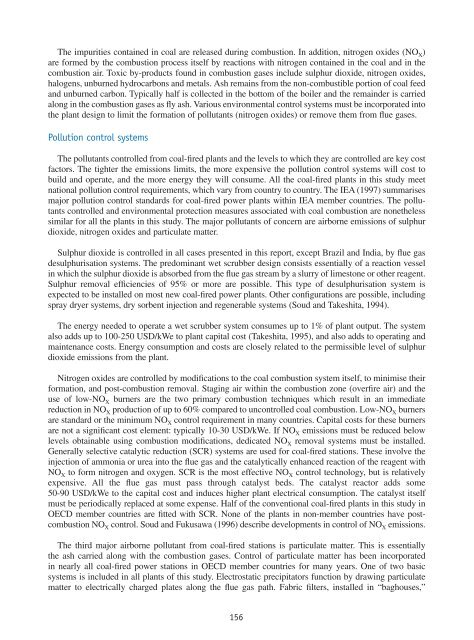Projected Costs of Generating Electricity - OECD Nuclear Energy ...
Projected Costs of Generating Electricity - OECD Nuclear Energy ...
Projected Costs of Generating Electricity - OECD Nuclear Energy ...
You also want an ePaper? Increase the reach of your titles
YUMPU automatically turns print PDFs into web optimized ePapers that Google loves.
The impurities contained in coal are released during combustion. In addition, nitrogen oxides (NO X )<br />
are formed by the combustion process itself by reactions with nitrogen contained in the coal and in the<br />
combustion air. Toxic by-products found in combustion gases include sulphur dioxide, nitrogen oxides,<br />
halogens, unburned hydrocarbons and metals. Ash remains from the non-combustible portion <strong>of</strong> coal feed<br />
and unburned carbon. Typically half is collected in the bottom <strong>of</strong> the boiler and the remainder is carried<br />
along in the combustion gases as fly ash. Various environmental control systems must be incorporated into<br />
the plant design to limit the formation <strong>of</strong> pollutants (nitrogen oxides) or remove them from flue gases.<br />
Pollution control systems<br />
The pollutants controlled from coal-fired plants and the levels to which they are controlled are key cost<br />
factors. The tighter the emissions limits, the more expensive the pollution control systems will cost to<br />
build and operate, and the more energy they will consume. All the coal-fired plants in this study meet<br />
national pollution control requirements, which vary from country to country. The IEA (1997) summarises<br />
major pollution control standards for coal-fired power plants within IEA member countries. The pollutants<br />
controlled and environmental protection measures associated with coal combustion are nonetheless<br />
similar for all the plants in this study. The major pollutants <strong>of</strong> concern are airborne emissions <strong>of</strong> sulphur<br />
dioxide, nitrogen oxides and particulate matter.<br />
Sulphur dioxide is controlled in all cases presented in this report, except Brazil and India, by flue gas<br />
desulphurisation systems. The predominant wet scrubber design consists essentially <strong>of</strong> a reaction vessel<br />
in which the sulphur dioxide is absorbed from the flue gas stream by a slurry <strong>of</strong> limestone or other reagent.<br />
Sulphur removal efficiencies <strong>of</strong> 95% or more are possible. This type <strong>of</strong> desulphurisation system is<br />
expected to be installed on most new coal-fired power plants. Other configurations are possible, including<br />
spray dryer systems, dry sorbent injection and regenerable systems (Soud and Takeshita, 1994).<br />
The energy needed to operate a wet scrubber system consumes up to 1% <strong>of</strong> plant output. The system<br />
also adds up to 100-250 USD/kWe to plant capital cost (Takeshita, 1995), and also adds to operating and<br />
maintenance costs. <strong>Energy</strong> consumption and costs are closely related to the permissible level <strong>of</strong> sulphur<br />
dioxide emissions from the plant.<br />
Nitrogen oxides are controlled by modifications to the coal combustion system itself, to minimise their<br />
formation, and post-combustion removal. Staging air within the combustion zone (overfire air) and the<br />
use <strong>of</strong> low-NO X burners are the two primary combustion techniques which result in an immediate<br />
reduction in NO X production <strong>of</strong> up to 60% compared to uncontrolled coal combustion. Low-NO X burners<br />
are standard or the minimum NO X control requirement in many countries. Capital costs for these burners<br />
are not a significant cost element: typically 10-30 USD/kWe. If NO X emissions must be reduced below<br />
levels obtainable using combustion modifications, dedicated NO X removal systems must be installed.<br />
Generally selective catalytic reduction (SCR) systems are used for coal-fired stations. These involve the<br />
injection <strong>of</strong> ammonia or urea into the flue gas and the catalytically enhanced reaction <strong>of</strong> the reagent with<br />
NO X to form nitrogen and oxygen. SCR is the most effective NO X control technology, but is relatively<br />
expensive. All the flue gas must pass through catalyst beds. The catalyst reactor adds some<br />
50-90 USD/kWe to the capital cost and induces higher plant electrical consumption. The catalyst itself<br />
must be periodically replaced at some expense. Half <strong>of</strong> the conventional coal-fired plants in this study in<br />
<strong>OECD</strong> member countries are fitted with SCR. None <strong>of</strong> the plants in non-member countries have postcombustion<br />
NO X control. Soud and Fukusawa (1996) describe developments in control <strong>of</strong> NO X emissions.<br />
The third major airborne pollutant from coal-fired stations is particulate matter. This is essentially<br />
the ash carried along with the combustion gases. Control <strong>of</strong> particulate matter has been incorporated<br />
in nearly all coal-fired power stations in <strong>OECD</strong> member countries for many years. One <strong>of</strong> two basic<br />
systems is included in all plants <strong>of</strong> this study. Electrostatic precipitators function by drawing particulate<br />
matter to electrically charged plates along the flue gas path. Fabric filters, installed in “baghouses,”<br />
156

















